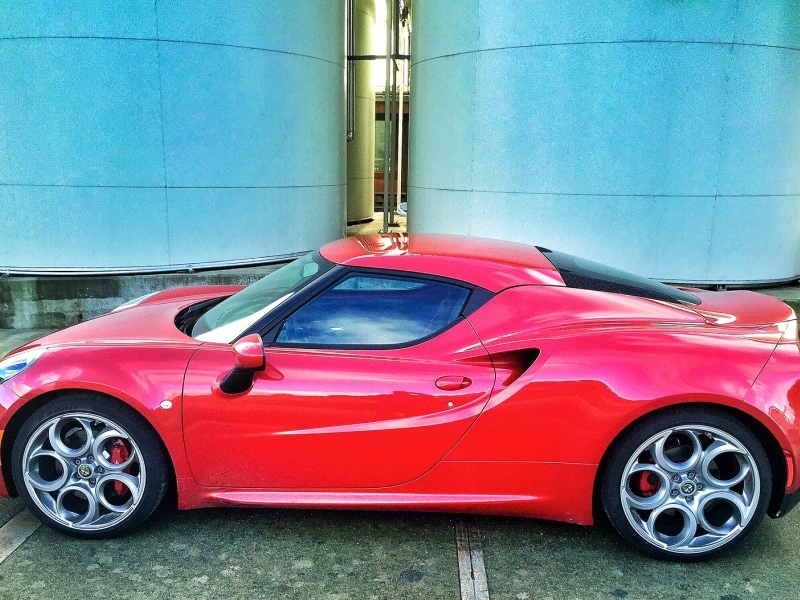Recent Articles
Popular Makes
Body Types
2015 Alfa Romeo 4C Road Test & Review
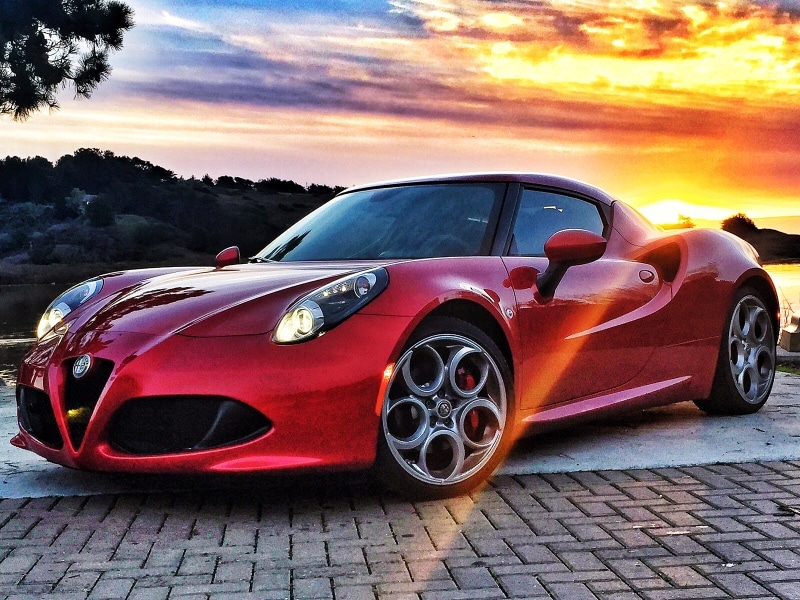
OK, so let’s get this said right off the top.
Alfa Romeo’s 4C is loud, stiff, noisy, lacks power steering, is difficult to get into and out of, has very little trunk space, and no real interior storage space. You sit so low to the ground everything else on the road looks both huge and threatening. Even a Miata looks big from inside the 4C.
Of course, that’s if you’re looking out of the windshield or side windows. Looking over your shoulder to the rear ¾, you only see the Alfa’s interior. Further, the rear window is very small and the glass engine cover complicates outward visibility, so your view to the rear is severely compromised as well. Trying to ease into a road at an angle is an exercise in faith, because you won’t see oncoming traffic.
So, if you’re thinking, “Wow that’s a lovely little car, I’ll get one for my daily driver.” You’re only half right. It is a lovely little car, but trying to live with the Alfa Romeo 4C as a daily driver entails way too many compromises. We strongly suggest you reconsider that proposition.
OK?
Good, now that we’re rid of the poseurs, those of you who really love to drive—read on.
Models & Pricing
At launch, Alfa Romeo is bringing the 4C to the United States in two levels of trim.
The 2015 Alfa Romeo 4C Coupe features—as standard equipment; 17-inch front wheels and 18-inch rear wheels wearing three-season performance tires; LED daytime running lights, tail lights, and halogen projector headlamps; aluminum racing pedals, high performance lightweight cloth seats, and a three-spoke flat-bottomed leather-wrapped steering wheel; air conditioning, remote keyless entry; power windows, locks, mirrors, and a Parrot Asteroid radio supporting MP3 capability as well as Bluetooth telephony and audio streaming.
Pricing starts at $53,900.
The 2015 Alfa Romeo 4C Coupe Launch Edition (of which only 500 will are being produced for the U.S.) contains all of the above, plus a numbered aluminum serialized badge (1 of 500, 50 of 500 and so on…), and a unique sport front fascia featuring bi-xenon projector headlamps. The exterior rear view mirror covers, rear spoiler, instrument cluster bezel, instrument panel, and shift paddles are made of carbon fiber.
The Launch Edition package also contains a dual race exhaust system and a high performance suspension system with 18-inch front and 19-inch rear dark forged five-hole wheels with three-season performance tires. Completing the 4C Coupe Launch Edition package are a set of Alfa Romeo red performance brake calipers, racing leather seats with microfiber inserts, accent stitching throughout the interior, and a steering wheel finished in leather and microfiber.
Pricing starts at $68,400.
Items featured on the 4C Launch Edition Coupe are also available as options for the base 4C Coupe. It should also be noted we’ve seen one dealer asking for a $40,000 markup on the Launch Edition 4C Coupe.

Design
Carbon fiber plays a huge role in the both the look and the performance of the 4C. The passenger cell is basically a sheet of carbon fiber, molded into shape with space for a driver and a passenger. Weighing a mere 236 pounds, it is exceptionally strong—and rigid.
Engineered by Alfa Romeo and handbuilt at the Maserati factory, every line on the Alfa 4C serves a purpose. The look is in homage to the 1967 Alfa Romeo 33 Stradale (strah-DOLLY). The word is Italian for “roadgoing”, as the 33 was a street legal version of the Alfa Tipo 33 racing car. This fits, because the 4C is also—for all intents and purposes—a racing car with a few concessions made for street use.
Every opening channels air to a mechanical component for either aspiration and cooling, or serves an aerodynamic function to maintain the Alfa’s stability at speed. The wonderful part is the designers accomplished this while incorporating signature Alfa Romeo styling cues like the triangular grille opening at the front of the car.
The shape of the grille informs the sculpting of the hood, while the oversized headlamp housings serve as a visual counterpoint and gives “eyes” to the Alfa’s face. At the rear, the two round taillamps echo those of some of the most potent performance cars in Italian history. Flowing forward from them are muscular rear fenders housing the wide rear tires, while also telegraphing the performance potential of the sports car.
Carved into those fenders are air vents to satisfy the engine’s cooling needs. There is similarly employed grille-work on both sides of the glass engine cover, which serves to showcase the 4C’s powerplant.
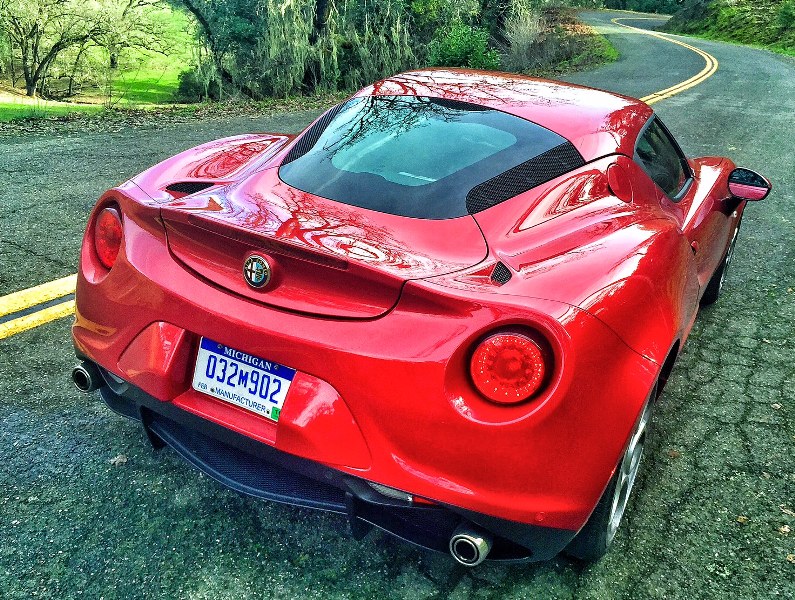
Features & Controls
The driver faces a single TFT instrument panel with a digital readout for speed. The tachometer is displayed as a graph arcing over the speed readout. The panel also displays the time, drive mode setting, transmission mode and gear, external temperature, turbo pressure, fuel level, coolant temperature, Gmeter reading, and oil temperature. The color of the display changes according to the drive mode you’ve selected and the color of the tachometer readout changes from white to yellow as redline is approached.
A bit busy at first glance, it makes sense after you’ve studied it.
The thick steering wheel is nicely sculpted and very Italian looking. The bottom of the wheel is flat to help inform you how much steering lock you have dialed in. In our opinion, the flat part could have been a bit narrower and the opening a bit deeper to make it easier to steer the car from the bottom of the wheel in steady state running along the highway.
A pair of paddles is attached to the steering wheel to accommodate shifting the transmission in manual mode. The left paddle downshifts, while the right paddle upshifts. They are very conveniently placed, though we would rather have seen them mounted to the steering column rather than the steering wheel so they'd always be in the same place, regardless of the steering wheel’s position.
To the right of the driver is one of the most confusing and least user-friendly radios we’ve ever seen installed in a car. Yes, it offers MP3 functionality, and Bluetooth audio streaming, but we’ve been driving the car for the better part of a week and have yet to figure out to turn it off. Further, it stays at the level it was at when you shut the car off, so the next time you get in and start the car it blasts you viciously. And yes, you will run the audio system loudly because the Alfa’s interior is so noisy. Best remember to turn it all the way down as part of your shutdown procedure.
The row of toggle switches just beneath the radio controls the door locks, air conditioning, and defroster function for the exterior rearview mirrors. The main climate control panel lives just beneath it. On the center console are the primary controls for the transmission, drive mode selector, rear view mirror adjustments, hazard lights, and power windows.
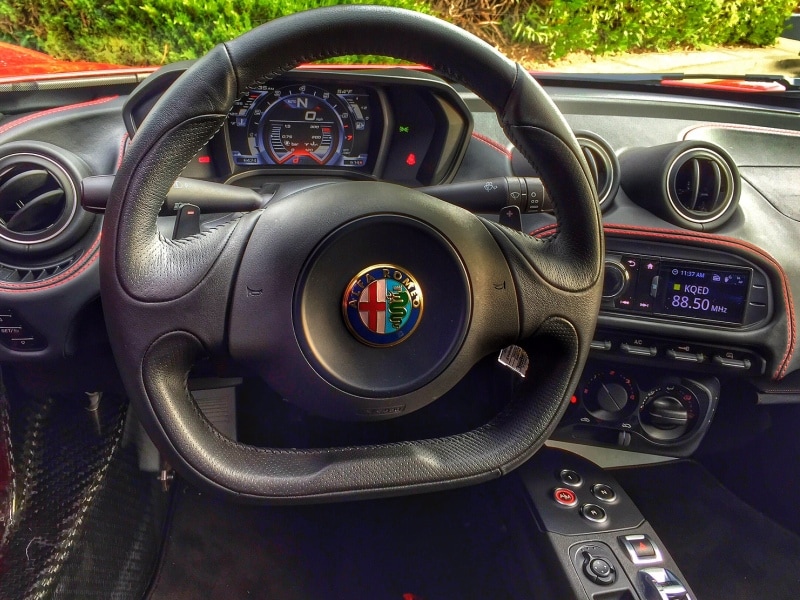
Comfort & Cargo
The driving position for the Alfa 4C is pretty much predetermined by the factory, as the seats offer no reclining function. This means the driver sits pretty much upright—not uncomfortably so, but upright nonetheless. Both seats are adjustable fore and aft, and the steering wheel offers both tilt and telescoping functions. The 4C allows itself to be tailored to various body types fairly easily.
Assuming, of course you can get into the car. The door sills are quite wide—to enhance the rigidity of the carbon fiber tub—and the car is low to the ground so getting in and out of the 4C with grace requires both a considerable amount of litheness and practice. On the other hand, while the interior is close-coupled, you don’t feel intruded upon by a passenger of average dimensions.
The climate control system requires a bit of fidgeting before you can find a comfortable setting, and you’ll probably wind up running the air conditioner even when using the heater because the interior is prone to fogging up, even when admitting outside air—not just when it is set to recirculate.
There are no armrests in the car whatsoever, so long drives will leave your arms a bit tired. Leather straps anchored to the doors are used to pull them closed. There are exactly three storage areas in the interior of the car. There’s a shallow leather pouch underneath the dash on the passenger side, just commodious enough to hold the owner’s manual (and only because it is on a DVD). There’s a circular storage tray behind the driver’s right elbow, a cupholder (just aft of it), and a very shallow storage pocket against the firewall behind the driver, which is just commodious enough to hold a smartphone in place—but it’s also awkward to reach, so…
The trunk is in the rear of the car, just aft of the engine—in fact you open the engine cover to access it. A support rod is included to hold it open. According to Alfa Romeo’s product literature it’s good for 110 cubic decimeters (that’s 3.9 cubic feet) of cargo.

Safety & Crash Test Ratings
Neither NHTSA nor the IIHS (Insurance Institute of Highway safety have subjected the Alfa Romeo 4C to crash testing. Given the limited production status of the Alfa sports car, this is not an unusual occurrence.
Standard safety gear includes anti-lock brakes, electronic stability control, a hill holder feature, tire pressure monitoring, anti slip regulation, and cornering brake control; as well as of course driver and passenger airbags. Options include a rear parking sensor array, and an anti-lifting alarm system with a second key and a remote control.
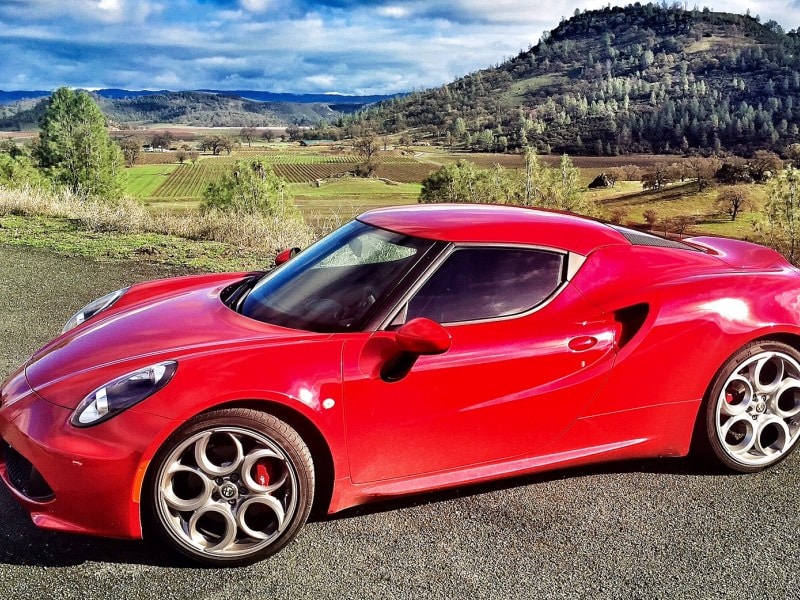
Engine & Fuel Economy
The mid-mounted 1750 cc turbocharged inline four cylinder engine powering the Alfa 4C’s rear wheels produces 240 horsepower and 258 ft-lbs of torque between 2,200 rpm and 4,000 rpm. The wet sump engine is liquid cooled and uses an intercooler for the turbocharger.
The transmission is a six-speed dual dry clutch semi automatic with paddle shifting and launch control. The driving mode selector offers a choice of All-weather (second gear starts to reduce wheel spin in slippery conditions), Natural (or normal operation), Dynamic (quickens gear changes and advances throttle response), and Race (disables ABS and stability control—in addition to the functions of the Dynamic mode).
The transmission also offers both manual and automatic shifting. The dual clutch design means the driveline remains engaged during shifts for acceleration with no hesitation between gear changes.
Fuel economy is rated at 24 miles per gallon in the city, 34 on the highway, and 28 combined.
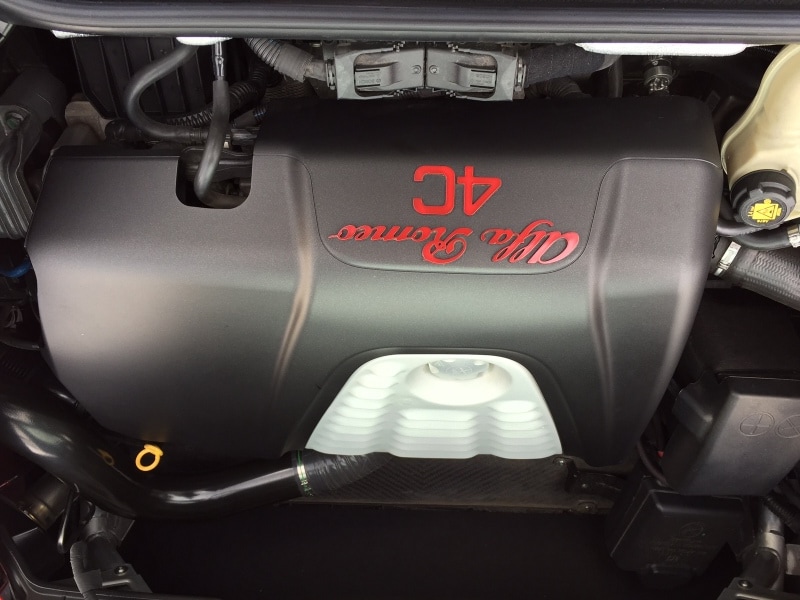
Driving Impressions
Remember the detriments we cited in the introduction?
They’re assets out on the open road.
The steering, while not power assisted, transmits all the information you need about the road surfac and cornering loads. Ditto the noisiness, you’ll always know exactly what the tires are encountering as they travel over the surface of the road because the sound varies accordingly. The loudness of the engine—well what true enthusiast doesn’t like the sound of a well-tuned engine running hard?
The low seating position places you literally inches above the road, so you feel part of the car as you hurtle along. And that’s exactly what happens. The 4C weighs approximately 2,400 pounds, so the engine has more than enough power to fling you along at pretty much any velocity you desire. Grip is absolutely amazing, and the brakes feel like they’re related to a brick wall—that’s how well they stop the car.
A Roomba for the road, the Alfa practically vacuums up pavement.
If you like to drive, you’ll love the Alfa Romeo 4C.
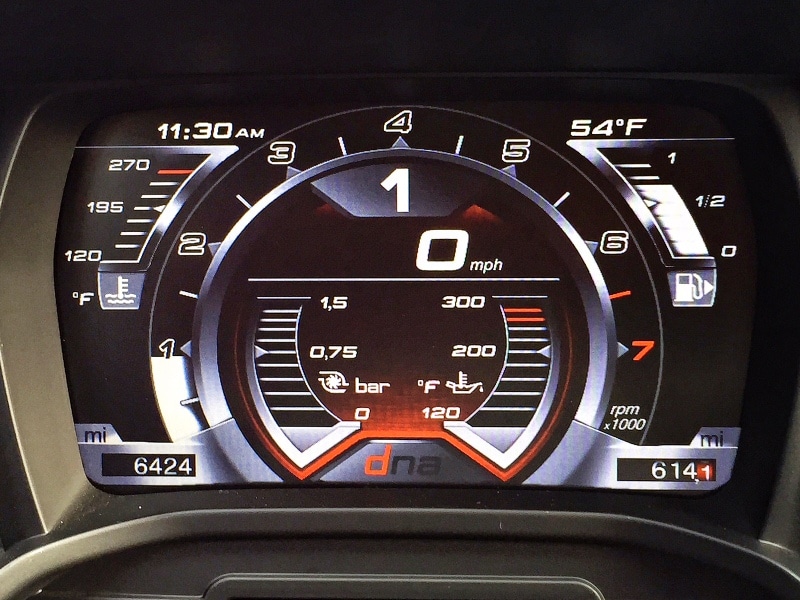
Final Thoughts
As a second or third car for fun driving, be it on back roads, track days, or autocross, the Alfa Romeo 4C is absolutely radiant. This is a highly elemental sports car—period. If you’re looking for a mid-engine sports car to drive every day, buy a Porsche Cayman.
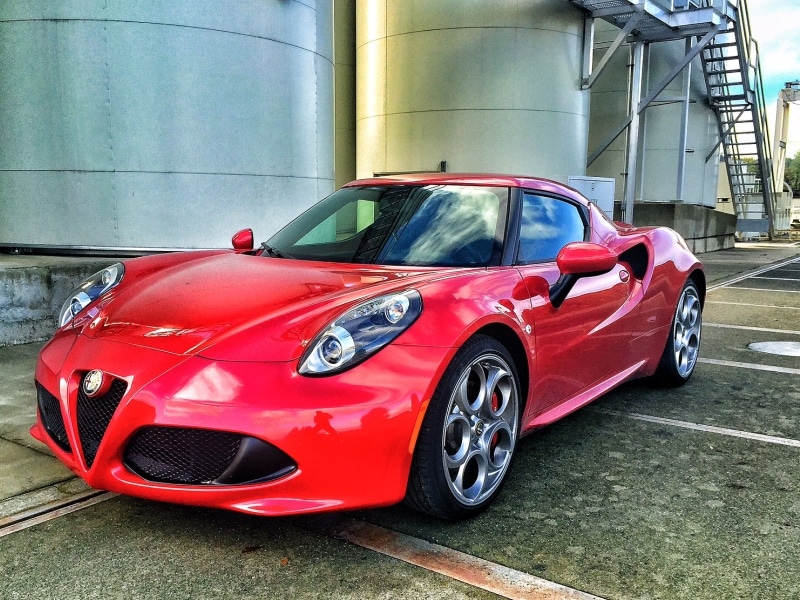
Pros & Cons
Pros: It's brilliantly fun car
Cons: It’s only a brilliantly fun car
